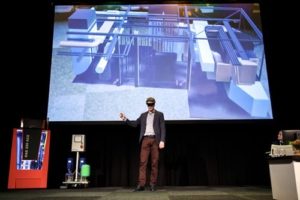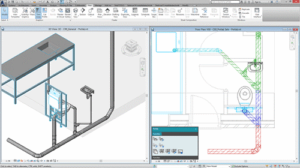« The construction industry never changes. Building is simply building. » If this expression comes up very often, the reverse is also true.
As a customer, you have already seen many trends that also influence the work of installers, modelers and advisers. How to draw the future? Uncertainty hangs over this issue but here are some trends expected for 2017.
- Virtual reality
Virtual Reality (VR) is about to experience a real revolution in the professional world. Mixed reality is a particularly interesting variation. Take for example the Microsoft HoloLens headset: these are glasses that merge real environments with virtual images and holograms. The result: you can have the experience of virtual reality in your own living room, office, workplace or on the construction site. During the SUM (Stabicad User Meeting) meeting, Stabiplan presented a number of applications that could work in the construction sector: for example, a 3D model of a technical room, a so-called “cascade” configuration of Remeha generated from actual data. Stabiplan has successfully demonstrated how to use this technology in a product in service. As holograms are adaptable and contain a lot of information, they offer an exciting perspective for various scenarios.

Présentation de la Réalité mixte par Stabiplan.
- Intuitive designs
The second trend is prefabrication. Construction sites are getting smaller, skilled workers more and more scarce and safety standards more and more strict. Prefabrication increases predictability, consistency and repeatability. It helps installers to work more efficiently. Installers can encrypt prefabricated sets according to individual wishes and benefit from the increasing automation of processes. These include the generation of prefabrication sheets and the placement of labels. Another advantage: quality libraries such as MEPcontent. The content is regularly checked by the manufacturer so that the engineers can be sure that they have all the latest information necessary for the (ordering) process, such as article numbers and prices. Result: guaranteed fluid information tracking, from design to assembly in the workshop, including ordering.
 Installers can encrypt the prefabrication elements with the prefabrication function in Stabicad.
Installers can encrypt the prefabrication elements with the prefabrication function in Stabicad.
- Tools « on demand »
Following the reduction in budgets, BIM engineers are led to design intelligently and efficiently. To do this, they need quality software. The difficulty remains flexibility which plays a major role here: different projects require different functionalities in your software. Take the well-known example of Netflix. This subscription model is emerging more and more in the world of design software. Software, updates and support are included in a monthly payment. Result: you can adapt them precisely to your needs. Specific design tools, available in the form of applications, are increasingly appearing on the market. The function you need is quickly installed in your project. The advantage is that you only pay for the application itself and not for all types of packages. Installers can, therefore, offer the flexibility required for the market without incurring excessive costs.
- Internet of things
In the construction industry, the Internet of Things (IoT or Internet of Things) is on everyone’s lips: everyday objects are connected to the Internet. IoT is an extremely promising technology for the construction industry because sensors are already present in many systems. The next step is to connect all the sensors to the Internet. Once the data is online, it can be stored in databases and monitored by applications. These include the new start-up Augury. The Augury system uses data from vibration and ultrasound sensors in HVAC equipment. It compares the data in real-time with the previous data of the same device as well as the data connected on similar machines. The platform can detect the smallest of changes and warn in the event of failures. This analysis occurs in real-time and the results are sent to your smartphone in a few seconds.

Everyday objects are increasingly connected to the Internet.
- BIM 5D
Architects, installers and consultants often use different platforms that you do not always synchronize correctly. As a result, no single source offers a real-time, integrated picture of design, costs and materials. Hence a disappointing performance. BIM 5D is a Penta-dimensional representation of the physical and functional properties of a project. It adds two properties to 3D BIM: costs and material. In addition to standard design parameters such as geometry, aesthetics, thermal and acoustic properties are also incorporated into a project. Engineers can judge from the start how much a decision affects the costs of a design.
Data, the queen trend
Combining these trends offers many possibilities for the entire construction chain. There remains, however, a “but” which is important: all the partners in the chain will have to accept BIM technologies to be able to benefit from the advantages of BIM. In addition, correct and consistent data and standards will have to be used, from design to implementation. In 2017, data will play a major role.
Source : https://www.stabiplan.com/fr-fr/nouvelles/nouvelles-et-blogs/le-bim-en-2017-les-5-tendances/ consulté le 25 Mai 2018
